Ford Puma ST
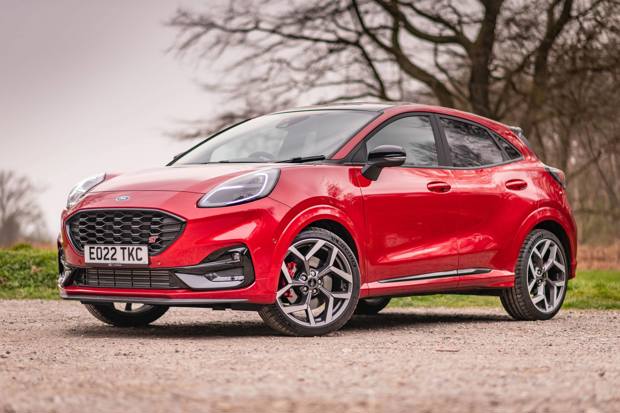

- Meet our long term Ford Puma ST
- Spot the difference: Puma ST vs Puma ST Line
- A closer look at the Puma ST's interior
- Slow puncture pauses the fun
- Our Puma ST gets its first proper road trip
- The Puma ST's boot is bigger than you think
- Ford Puma ST vs Audi SQ2
- Puma ST fuel economy
- Ford Puma ST is proof manual cars are best
Meet our long term Ford Puma ST
How does the Puma ST's blend of sportiness and practicality fit in with daily family life?
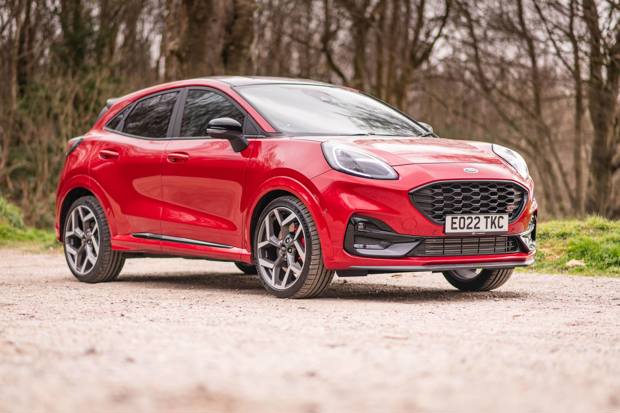
Date: 1 April 2022 | Current mileage: 153 | Claimed economy: 41.5mpg | Actual economy: 34.1mpg
The Ford Puma is regularly one of the best-selling cars in the UK, and for good reason. We reckon it's one of the best small SUVs you can buy, mixing sporty styling, a high-up driving position, plenty of space and representing good value for money.
But after running the sensible Ford Kuga for the last 6 months I was after something a little more fun, which brings me to the Puma ST you see here. While still being a roomy and practical 5-door small SUV, it benefits from most of the mechanicals that are found in the Ford Fiesta ST hot hatch.
So rather than having one of Ford's 1.0-litre engines under the bonnet, the Puma ST enjoys the 200PS 1.5-litre three-cylinder petrol unit from the Fiesta ST, albeit with an extra 30Nm of torque that will see the Puma ST hit 62mph in as little as 6.7 seconds.
The engine though is just part of the story, with Ford Performance setting to work on optimising the chassis that sees a bespoke twist-beams, anti-roll bar and damper configurations. The steering response has also been tinkered with to be 25 per cent faster, while the brakes are some 17 per cent larger than the standard Puma. That's not forgetting the specially-developed Michelin Pilot Sport 4S tyres fitted to our Puma ST's 19-inch Magnetite machined alloy wheels.
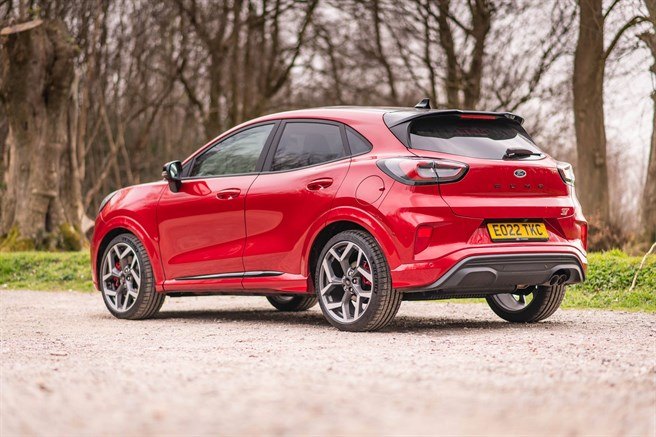
Our long-term Puma ST is also spec'd out with the ST Performance Pack. This £950 extra features a limited slip diff (LSD) to help reduce front-drive understeer as you hustle it into a bend, as well as launch control if you're feeling that way inclined.
I'll cover off the main features later (you get plenty of standard kit), but our Puma also comes with Ford's Driver Assistance Pack at £600. This bundle of tech includes adaptive cruise control, blind-spot monitoring and a rear parking camera among other things. For £350 we've also got that handsfree power tailgate to make life easier when loading or unloading the car.
The standard colour but we've opted for Fantastic Red at £525 (though we'd almost be tempted to go with Mean Green next time). That brings the total price up to £32,020 from a starting price of £30,545, making it that bit more affordable than rivals like the Hyundai Kona N and four-wheel drive options like the Volkswagen T-Roc R.
Designed to appeal to those who've outgrown a hot hatch but still want something fun to drive when not on family duties, it's going to be very interesting to see what the Puma ST is like to live with on a daily basis.
Spot the difference: Puma ST vs Puma ST Line
We take a look at some of the design touches that separate the Puma ST from the Puma ST Line.
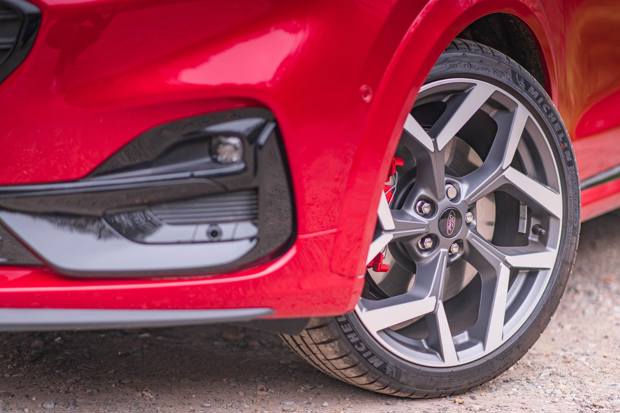
Date: 15 April 2022 | Current mileage: 217 | Claimed economy: 41.5mpg | Actual economy: 36.5mpg
While the slightly frog-eyed appearance from the front might to be to everyones taste, we reckon the Ford Puma is one of the best-looking small SUVs on the market today. In ST guise we reckon it looks the business, but how can you tell an ST apart from a standard Puma in ST Line trim?
Ford's ST Line trim level has become a popular choice among buyers as it goes someway to making your Ford look like a ST performance model, with a sporty body kit on the outside that mimics the Puma ST, while there are also changes inside, including a flat-bottomed steering wheel and red stitching on both the doors and seats.
But if you're spending upwards of £5000 extra on a Puma ST, you want it to stand out from the crowd, so how does your SUV hot hatch manage to do that?
Let's start with the exterior. The body kit that's on the ST Line is the same as the ST, but there are some telling differences. Perhaps the most obvious one is the addition of a Ford Performance front splitter, while there's a more pronounced roof spoiler as well.
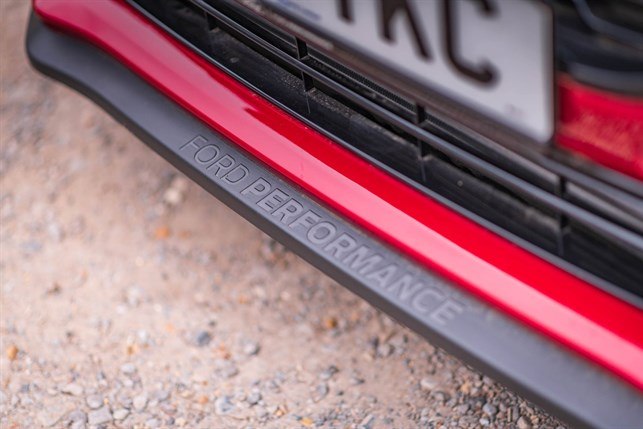
The a generous dollop of gloss black paint as well. With the roof, rear spoiler and door mirror caps all getting the same treatment. That's not forgetting the twin exhaust pipes protruding out of the Puma ST's rear and the ST badges adorning the front and rear of the car.
Finishing this all off are the large 19-inch alloy wheels that the Puma ST sits on are a noticeable step up from the 17-inch alloys that the ST Line comes with. The upgraded ST Line X sports 18-inch alloys that go someway to mimicking the ST's 5-spoke alloys, but don't quite hit the mark.
Inside and the standard seats of the ST Line car are replaced by chunky Recaro seats with big bolsters to keep you firmly in place. And just to remind you're in an ST (if the handling and engine note aren't a giveaway), there are ST badges sprinkled throughout the interior. And when it's dark outside the puddle lights project the ST logo onto the ground to leave you in no doubt what you're about to get into.
While these various treatments might not sound a lot on there own, add them together and the result is a much more purposeful looking car than the standard car.
A closer look at the Puma ST's interior
Is there a sense of occasion when you jump behind the wheel of Ford's crossover hot hatch?
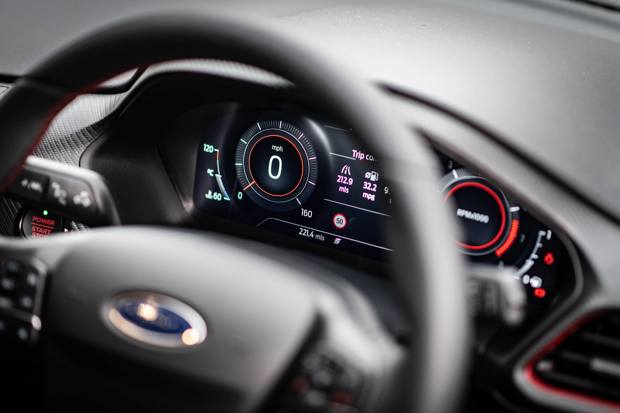
Date: 29 April 2022 | Current mileage: 401 | Claimed economy: 41.5mpg | Actual economy: 37.4mpg
I've talked quite a bit about the features and looks of the Puma ST, but haven't really touched on the experience of getting behind the wheel of it. Buckle up because I'm about to do just that.
Our Puma ST has keyless entry so there's no need to press the keyfob to unlook the car. Simply touching the door handle unlocks the Puma ST and you're in. Access is nice and easy (let's not forget, it is a small SUV after all) even with the heavily bolstered Recaro sports seats.
These Recaro seats are superb. They offer plenty of support and are extremely comfortable, with a good amount of adjustment to boot. The driving position is great though, with the steering wheel and pedals perfectly aligned with the Puma ST's chunky seat.
Because you sit around 3cm higher in the Puma compared to the Fiesta, it's no surprise to find the driving position is that bit higher as well. You don't feel like you're sitting on top of the car though, while those wanting an even higher driving position should probably be looking at something else.
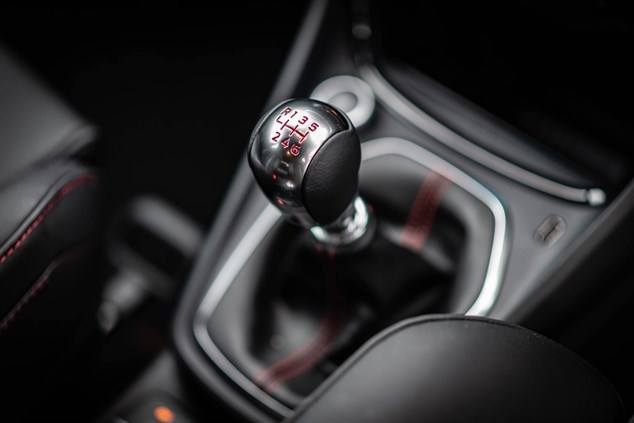
Both the 12.3-inch digital display and touchscreen interface flash up with Ford's ST logo when you get in, while a press of the ST button on the steering not only optimises the car's performance, but the graphics on the digital dash also change from an approachable blue to a more serious grey.
Fit and finish is good, with all the key touch points up to a good standard. The top parts for the front doors are finished in leather as well, but further down and this is replaced by a somewhat scratchy plastic.
The smooth metal finish of the gear knob is great, with a lovely short-shift action. If we're being picky, the gear knob could do with being a little bit longer so it falls to the hand a bit more naturally. Or I could just have short arms.
There's lots to like about the Puma ST's interior, though I can't help feeling it could be a little more special when you first get inside. That said, as soon as you put your foot down on the clutch and press the starter button, that all changes as the engine fires into life...
Slow puncture pauses the fun
A stray screw brings on a slow puncture that sees us put Kwik Fit's mobile tyre fitting to the test.
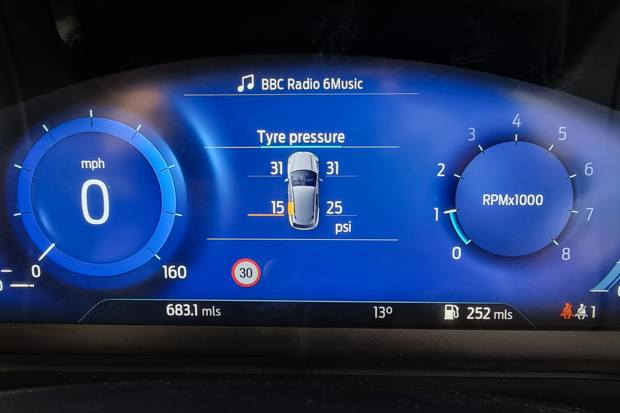
Date: 13 May 2022 | Current mileage: 517 | Claimed economy: 41.5mpg | Actual economy: 36.7mpg
After running our very sensible VW Golf long termer for a bit, the transition to the Puma ST has been quite a jolt. The contrast couldn't be more extreme, with the Puma ST a much more visceral experience. Even the school run becomes fun but that came to a juddering halt last week.
Jumping into the car to pick the girls up from school and the low tyre pressure warning display popped up on the digital dash. I'd lost pressure in the left rear so once I'd got back from the school run I took a closer look at the tyre to find a horrible screw poking out of the tread.
Being close to the sidewall of the tyre it didn't look like it was repairable. More annoying was the fact that it seemed like such as waste - the tyre had only put around 500 miles on it and it was ready for bin.
Not wanting to be out of action for too long, I phoned my local Kwik Fit to see if they could take a look at it. "Sure, no problem" they said, "you can run it round now if you like". Brilliant, but once I got there I was gruffly told that they were busy and could try tomorrow afternoon.
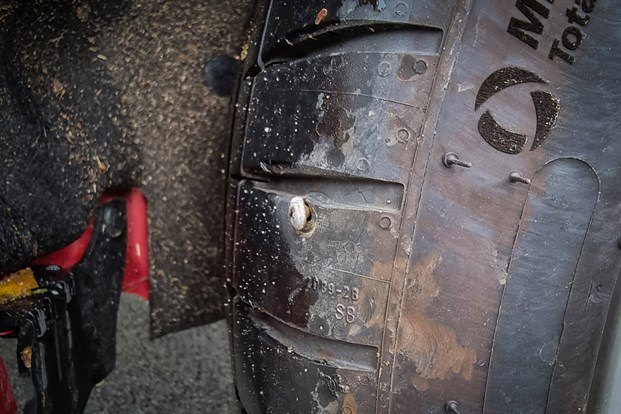
Not wanting to waste anymore time going back and forth, I thought I'd take a chance booking in Kwik Fit's mobile tyre fitting service. They had slots, but I'd have to wait a couple of days for availability. It was still drivable and I wasn't going that far, so I booked it in.
The tyre was still losing pressure though and with the Puma's MegaBox taking up space were a spare wheel would normal be, there wasn't the option to fit a temporary wheel. Ford don't leave you high and dry though - there's a tyre inflation kit tucked away in the side of the Puma's boot (where you'll also find the locking wheel nut).
The kit includes some sealant and compressor but I opted to use the Sealey MAC03 tyre inflator I had and brim it up each morning as it wasn't losing too much pressure over a 24 hour period.
That said, I was glad to have the man from Kwik Fit arrive and replace the tyre - all done in under half and hour and I didn't have to leave home. With a new Michelin fitted I'm ready for the family trip to France where the Puma is going to get its first proper long blast.
Our Puma ST gets its first proper road trip
A family holiday to France means our Ford Puma ST really gets to stretch its legs.
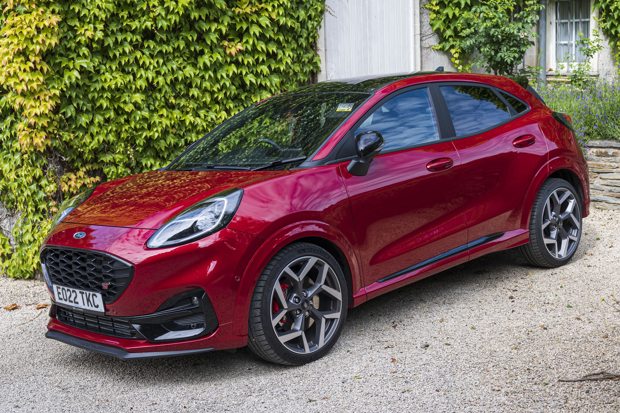
Date: 27 May 2022 | Current mileage: 1664 | Claimed economy: 41.5mpg | Actual economy: 39.5mpg
The Puma ST has bedded itself in nicely to daily life, but what would it be like on a big family road trip to France? With a week booked in the Loire we were about to find out.
Now, if we’re honest the Puma ST isn’t probably everyone’s first choice when it comes to transporting a family of four and a week’s worth of luggage over 450 miles in relative comfort. But that was the challenge.
Space is a big concern when packing for a holiday, so let’s talk about the Puma ST’s boot space. Just like the standard Ford Puma, the Puma ST has a boot capacity of 456 litres. This includes the very handy ‘Megabox’ - an 80-litre compartment that sits under the top section of the boot. Granted we were traveling light with no kids, bikes etc, but the Puma ST happily swallowed up all the stuff we packed for the week with room to spare.
With the Puma ST’s 45 litre fuel tank (3 litres larger than the standard Puma) brimmed up it was time to head down the M20 and towards the Eurotunnel terminal. A quick change of the Puma ST’s digital dash before we came out the other side meant we were ready to hit the A16 with a kmh readout - something almost impossible to do on a recent trip with our LT Volkswagen Golf.
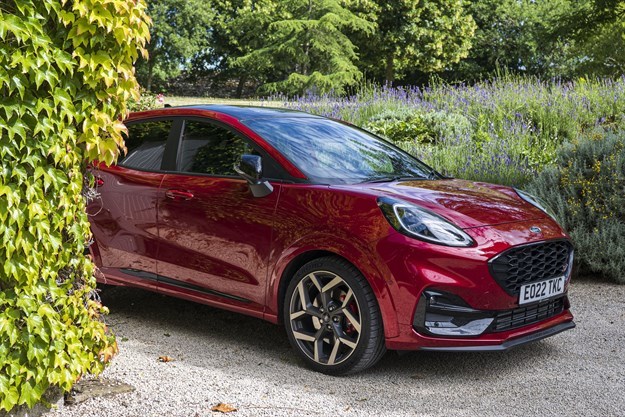
Once on the pan-smooth Autoroutes heading down to Le Mans and beyond, the Puma ST settled into a surprisingly good motorway cruiser. With the cruise control set to 130 kmh, the Puma ST bolted along happily. Even the Puma ST’s firm suspension set-up wasn’t an issue thanks to the excellent road surface that we glidded across, while the 10-speaker B&O system came into its own over 8 hours in the car.
Rather than rely on the Puma ST’s navigation, we used Google Maps via Android Auto. It worked seamlessly, but as I’ve said in the past, it’s annoying there’s no wireless connectivity. Fuel economy was pretty unspectacular as well, averaging around 40.5mpg for the journey down, which meant one stop to fill up.
If I was in an electric car though, I think they whole drive down could have been a much more stressful experience as it seems France is even further behind Britain when it comes to a charging infrastructure. Some people might have had a much more positive experience, but it’s not a journey I’d be in a rush to take in an EV.
Back to the Puma ST and while I’d had my reservations about it before setting off, these had evaporated by the time we’d arrived at our accommodation. There’s certainly better cars for those long drives but the Puma ST really surprised us by how comfy and practical it was on a long run and I wouldn’t hasitate to do it again.
The Puma ST's boot is bigger than you think
Thanks to the addition of the MegaBox, the Puma ST punches well above its weight when it comes to boot space.
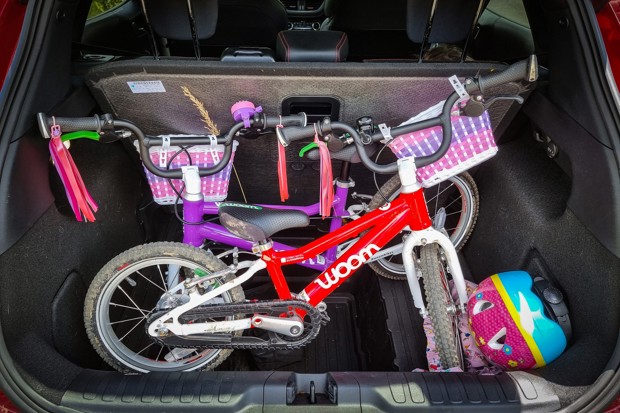
Date: 10 June 2022 | Current mileage: 1894 | Claimed economy: 41.5mpg | Actual economy: 37.7mpg
Part of the sell of the Puma ST over something like a Fiesta ST is the mix of hot hatch performance with some added practicality. Okay, there's some very tempting fast estates that tick that box as well, including the Volkswagen Golf R and Skoda Octavia vRS, but they haven't got quite the same fun-factor as the more compact Puma ST.
As I touched on in my last update, I was really impressed with how the Puma coped with a week's worth of luggage for a family holiday. This is all thanks to the brilliant MegaBox that sits underneath the boot floor and increases capacity by some 80 litres.
Now that might not sound too much on its own, but it's the extra useful space it brings makes the Puma ST stand out from the competition. It means I've been able to get things packed in the boot that I haven't been able to do in other similarly sized cars, including a Volkswagen Golf and Audi SQ2 (more on that next time).
Case in point. I've got two little girls who like to take their bikes to the local 'trim trail'. The Golf's 381-litre boot couldn't fit them in, and the same goes for the SQ2's 405-litre boot. But the boot of the Puma ST happily swallowed them up with plenty of space for helmets and other bits.
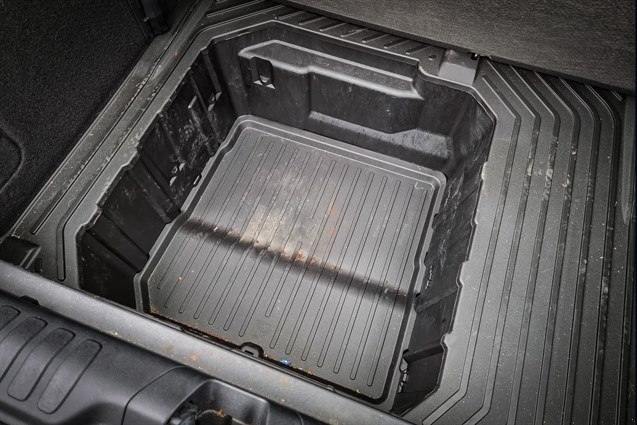
That's all thanks to the MegaBox. The Puma's standard boot space grows from 376 litres to a very decent 456 litres once you lift the boot floor up and back to reveal the extra storage. It's also significantly better than the Fiesta's boot by some 164 litres.
It's not just great at transporting bikes either. Our dog, Mary, also happily fits in the boot when needed. She won't thank me for saying this, but she's not the smallest dog in the world either, being a cross of lab and staffie.
The fact that the MegaBox can be easily cleaned is also a bonus (unlike the boot floor, which acts like velcro to dog hair). There's a plug at the bottom that means you can hose it out if you wish and pull the plug to drain the water out afterward. From muddy boots to old cooking oil that's going to the tip, it's really handy being able to chuck dirty bits of kit in there knowing any debris can be easily washed away.
Would more space be nice? Yes, especially as the family grows and bikes get bigger, but right now I've been really impressed by the boot capacity of the Puma ST.
Ford Puma ST vs Audi SQ2
We see how our Puma ST fairs when it goes up some pricier competition.
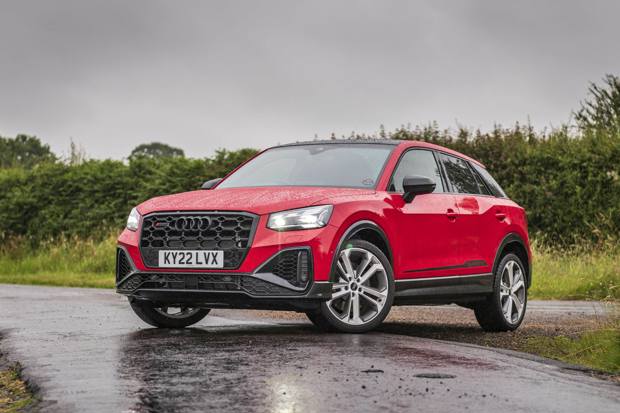
Date: 24 June 2022 | Current mileage: 2027 | Claimed economy: 41.5mpg | Actual economy: 36.9mpg
When you start looking around, our Puma ST doesn't appear to have that much in the way of direct competition. Especially at this price point. Dig deeper, though, and there's the Volkswagen T-Roc R and Hyundai Kona N, as well as Audi's hot Q2, the SQ2.
And the latter is what we're putting our Puma ST up against. Let's get the price out of the way first as that's perhaps the biggest thing that separates the two hot SUVs. You see, while the Puma ST starts at £30,270 (and you'd be hard pushed to go over £34,000 with options), the Audi SQ2 starts at just over £41,000. You're looking at over £48,000 for the fully kitted out Vorsprung edition.
That's quite a jump up from the Puma ST, so where does that extra money go? Like the Puma ST, the SQ2 takes many of its mechanical bits from a hot hatch, enjoying the the same engine, gearbox and four-wheel drive system as the old Volkswagen Golf R.
That translates to 300PS and a 0-62mph time of just 4.9 seconds via the SQ2's DSGs gearbox. On paper that's some 1.8 seconds than our Puma ST, but in reality it doesn't feel that much quicker. The SQ2 doesn't quite have the satisfying burble that the Puma ST makes when you first start it up either.
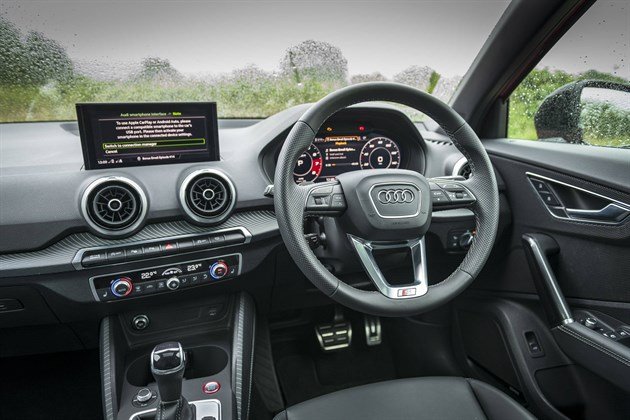
Inside and it's no surprise to find that the SQ2's cabin has the edge of our Puma ST's. The materials and finish are just that bit more tactile than those found in the Ford, but then you'd hope so for the premium you're paying. The SQ2's interior is starting to show it's age though - the screen is tiny (though the resolution of the reversing camera is nice and sharp), while space for your phone in the centre console is limited unless you're still rocking a Nokia 6610.
The SQ2's 405-litre boot is pretty decent but as I touched on in my last update, it's not quite as versatile as the Puma ST's. The 80-litre MegaBox is a huge trump card and stretches the Puma ST's boot capacity to some 456 litres.
Get behind the wheel of the pair and while the Puma ST always feels 'on', the SQ2 is a bit more Jekyll and Hyde. In it's comfort mode and the SQ2 is a very easy car to live with - the DSG gearbox makes things nice and easy round town, while the suspension sees the SQ2 easily navigate the iffy road surfaces of Surrey. Select dynamic driving mode and the character of the car completely changes and becomes much more of a hooligan.
So, which one? To live with on a daily basis, then the SQ2 edges it, but you can't ignore the fact that it costs almost 50% more than the Puma ST. In many ways the SQ2 only highlights further what great value the Puma ST is.
Puma ST fuel economy
From short trips to longer journeys, how does the Puma ST's fuel economy fair?
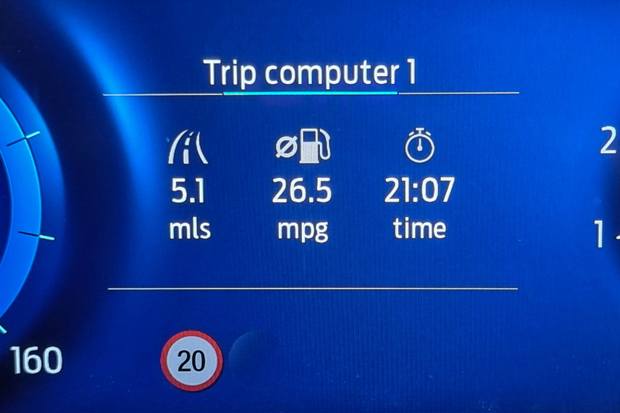
Date: 8 July 2022 | Current mileage: 2678 | Claimed economy: 41.5mpg | Actual economy: 37.8mpg
Buy a small SUV and one of you main considerations is fuel economy. Buyers of the standard Puma can expect upwards of 51.4mpg if they plump for the 125PS 1.0-litre mild-hybrid engine. But what about the fuel economy of our Puma ST?
After running a plug-in Ford Kuga I'd got used to rarely bothering the petrol station, instead topping up the battery at home for those weekly short trips. With the Puma ST though, I feel like I'm now on first name terms with the cashiers at our local filling station.
You see, doing regular short trips sees the fuel gauge plummet. And that's me trying not to drive like a yob either - changing up before I get a 'recommendation' to do so and driving in the Puma ST's normal mode. On daily short, local drives I'm lucky if I'm hitting 27mpg.
On the times I've almost been running on empty for one reason or another, the remaining range drops off a cliff. Even with some pretty sedantry driving.
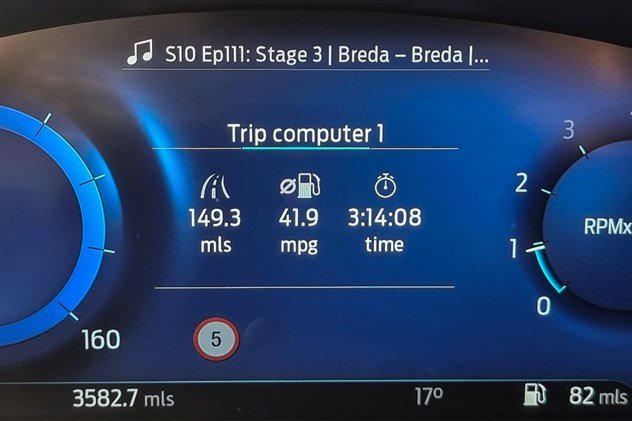
Things are better on longer runs though. As I've mentioned previously, we hit over 40mpg on a trip down to France recently, while a Sunday evening drive back from Norfolk saw us almost hit 42mpg over a mix of A roads and motorways.
It was a different story on the drive up though - with multiple hold ups that meant plenty of creeping along and sitting in traffic, we did well to hit 37mpg. Quite a contrast to the old family 1.4-litre Skoda Octavia that would happily tick over 50mpg without much effort on a longer drive.
With the Puma ST marketed as a bit of a bridge between the world of hot hatches and more grown-up SUVs, chances are it's going to be used just as much for humdrum trips as it is B road blasts, so even if fuel economy isn't a key criteria, it's certainly something to consider.
But the Puma ST will do something the standard car just can't do and that's put a smile it'll put on your face for the times you have a clear road. For for many potential buyers that's a worthwhile trade-off.
Ford Puma ST is proof manual cars are best
Are manual cars better than automatics? The question is answered with the excellent Ford Puma ST, says Dan Powell.
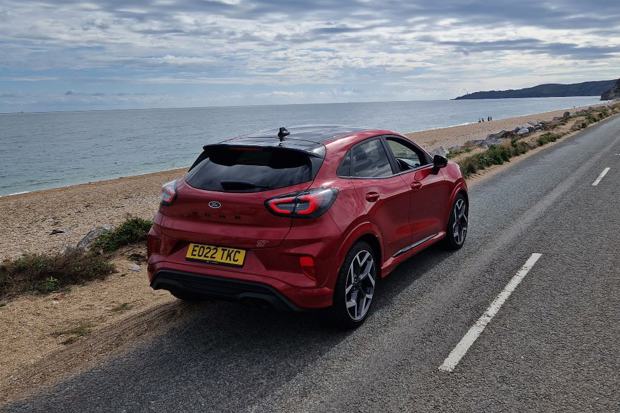
Date: 22 July 2022 | Current mileage: 3019 | Claimed economy: 41.5mpg | Actual economy: 39.9mpg
By Dan Powell
No auto? No problem. The Ford Puma ST is a brilliant hot SUV that provides all of the evidence you'll ever need to show that manual cars are still the best for performance. But enjoy them while you can, because the switch to electric will make manual cars like the Puma ST museum pieces.
In the not-too-distant future, we'll all be driving the best electric cars with fully automatic transmissions that will do all of the cog work for us. And while that might sound good for driving to work or visiting the local supermarket, it'll be something of a travesty for performance cars.
I admit that automatic gearboxes have improved a lot in recent years, which means they are not the slow and hesitant things they once were, they're still no match for a human with a manual gearbox. And the Puma ST is a case in point.
This is a great car to drive, with its low kerbweight and grippy front-wheel drive system making it perfect for twisty A roads. And it's the manual gearbox that unlocks the true thrills, with its short-shift making it easy to snap up the cogs or hold the revs as you navigate a challenging bend in the road.
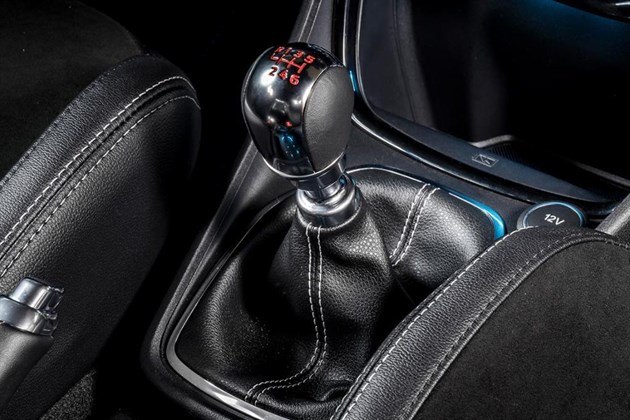
I moved to Devon in 2021. And this means I have access to some of the best roads in the country, which the Puma ST feels custom-made for. The steering is precise, the chassis is agile and the stiff suspension makes it easy to judge the Puma's handling in dry and wet conditions.
There are some drawbacks. After swapping my comfy and efficient Lexus NX, I find the Puma's hard ride quality somewhat jarring at times. The sub-40mpg fuel economy is also something that will leave a mark on your bank balance.
Not that many Puma ST buyers will care as they rasp down the road in their fast Ford. It's really impressive how Ford's engineers have overcome the physics (and high centre of gravity) to make the Puma ST a worthy rival to some of the best hot hatches.
I don't think the Puma ST would be half the car it is with an automatic gearbox. And this is why I think it is one of the last hurrahs of the great fast Fords. Treasure them while you can, they'll be collectors' pieces in the 2030s.
